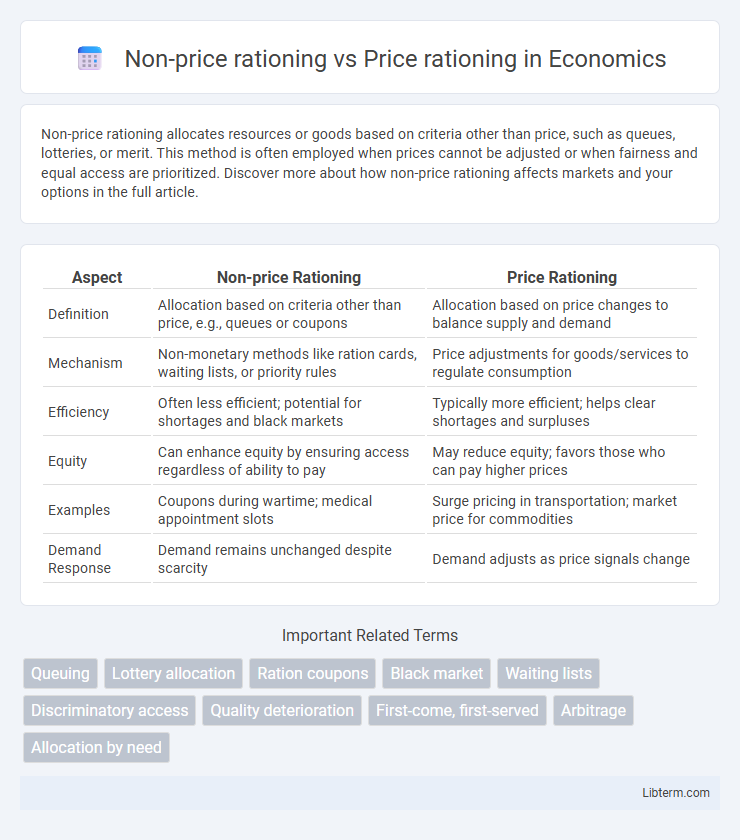Non-price rationing allocates resources or goods based on criteria other than price, such as queues, lotteries, or merit. This method is often employed when prices cannot be adjusted or when fairness and equal access are prioritized. Discover more about how non-price rationing affects markets and your options in the full article.
Table of Comparison
| Aspect | Non-price Rationing | Price Rationing |
|---|---|---|
| Definition | Allocation based on criteria other than price, e.g., queues or coupons | Allocation based on price changes to balance supply and demand |
| Mechanism | Non-monetary methods like ration cards, waiting lists, or priority rules | Price adjustments for goods/services to regulate consumption |
| Efficiency | Often less efficient; potential for shortages and black markets | Typically more efficient; helps clear shortages and surpluses |
| Equity | Can enhance equity by ensuring access regardless of ability to pay | May reduce equity; favors those who can pay higher prices |
| Examples | Coupons during wartime; medical appointment slots | Surge pricing in transportation; market price for commodities |
| Demand Response | Demand remains unchanged despite scarcity | Demand adjusts as price signals change |
Introduction to Rationing Mechanisms
Non-price rationing allocates goods and services through methods such as queues, lotteries, and ration coupons, typically used when prices are fixed or regulated to prevent market imbalances. Price rationing relies on price as the primary mechanism, where market forces of supply and demand determine the allocation based on consumers' willingness and ability to pay. Understanding these rationing mechanisms helps analyze how scarce resources are distributed during shortages or market interventions.
Defining Non-Price Rationing
Non-price rationing refers to methods of allocating scarce resources without changing the price, often through mechanisms such as waiting lists, lotteries, or quotas. It contrasts with price rationing, where price adjustments regulate demand and supply balance. Non-price rationing is commonly used in markets with price controls or essential goods to ensure equitable access.
Understanding Price Rationing
Price rationing allocates goods and services based on individuals' willingness and ability to pay higher prices, effectively using price as a signal to balance supply and demand. It encourages efficient resource distribution by incentivizing producers to increase output when prices rise and consumers to reduce consumption, thereby preventing shortages. Understanding price rationing is crucial for grasping how market economies regulate scarce resources and respond dynamically to changes in demand.
Key Differences Between Non-Price and Price Rationing
Non-price rationing allocates scarce resources through mechanisms such as queues, lotteries, or quotas, bypassing direct price adjustments and often leading to inefficiencies like long wait times or unfair access. Price rationing uses price signals to balance supply and demand, where higher prices reduce demand and allocate goods to those willing to pay more, thus promoting market efficiency and resource optimization. Key differences include the role of prices as rationing tools, the impact on consumer behavior, and the efficiency of resource distribution between the two approaches.
Historical Examples of Non-Price Rationing
Non-price rationing methods, such as ration cards during World War II in the United Kingdom and the United States, effectively controlled scarce resources by limiting quantities without altering prices. These historical examples demonstrate how governments prioritized essential goods like food, fuel, and clothing to ensure equitable distribution amid shortages. Unlike price rationing, which adjusts supply through market prices, non-price rationing relies on administrative controls to manage demand during crises.
Economic Principles Behind Price Rationing
Price rationing operates on the economic principle of supply and demand, where prices adjust to balance quantity supplied and quantity demanded, efficiently allocating scarce resources. Non-price rationing relies on alternative mechanisms such as queues or lotteries, which can lead to inefficiencies like wasted time and decreased consumer surplus. Price rationing incentivizes producers and consumers to respond to market signals, promoting optimal distribution and resource utilization.
Advantages of Non-Price Rationing
Non-price rationing offers advantages by ensuring equitable access to scarce resources regardless of consumers' ability to pay, promoting fairness in allocation. It can prevent market distortions caused by excessive price fluctuations and reduce the risk of inflationary pressures during shortages. This approach enhances social welfare by prioritizing needs and maintaining stability in essential goods distribution.
Benefits of Price Rationing
Price rationing efficiently allocates scarce resources by allowing market forces of supply and demand to determine prices, ensuring goods go to those who value them most. It reduces shortages by encouraging producers to increase supply and consumers to moderate demand based on price signals. This mechanism promotes economic efficiency, encourages innovation, and supports fair competition by reflecting true market conditions.
Challenges and Drawbacks of Each Rationing Method
Non-price rationing faces challenges like inefficiency and potential unfairness, as it often relies on administrative decisions or queues that may not reflect true consumer preferences or urgency. Price rationing can lead to inequality and reduced access for lower-income consumers, as higher prices may exclude those unable to pay, despite product availability. Both methods struggle with balancing fairness and efficiency, causing market distortions and potential welfare losses.
Choosing Between Non-Price and Price Rationing: Policy Implications
Choosing between non-price rationing and price rationing involves evaluating the economic and social impacts on resource allocation and equity. Price rationing efficiently allocates scarce resources by adjusting prices to balance supply and demand but may lead to income inequality and limited access for lower-income groups. Non-price rationing, such as quotas or waiting lists, aims to ensure fairness and controlled distribution but can cause inefficiencies, black markets, and administrative challenges in policy implementation.
Non-price rationing Infographic

 libterm.com
libterm.com